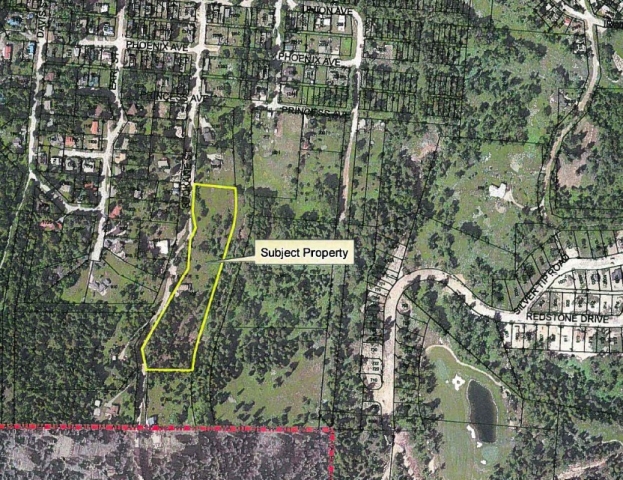Council denies developer’s plan for 50 townhouse units in Lower Rossland
Chris Jasinski, the owner of 908 Spokane St., a five acre (two hectare) lot beside the Railgrade Trail above the golf course, applied to council to rezone his property from 11 residential units to 51 units, but the application was denied.
Mark Martin, the project consultant and formerly Rossland’s city planner, spoke in favour of the development during the public input period, but council unanimously supported a staff recommendation to reject the application.
The staff memo to council said the proposal did not align with OCP (Official Community Plan) policies that restrict high-density residential areas to particular core zones. The land is sandwiched between Spokane Street uphill to the west and the Railgrade Trail downhill to the east.
Nevertheless, staff also noted, “The economics of the fully developed site (with proposed densities) provides a positive revenue stream and results in upgrades or extensions to existing infrastructure.”
The land has been rezoned before. In 2006, council supported Jasinski’s application to change the single lot from Rural-Residential to “CD-5,” increasing the potential density from a single family residence on one lot to five single family units plus three two-family units on a total of eight lots.
Now Jasinski’s plan is to build a series of townhouses totalling 50 units over 7 lots, plus a single family residence on the eighth lot.
The city planner, Mike Maturo, found that OCP policies “both support and challenge” the proposal.
On the one hand, the proposal increases higher residential density, housing forms other than single family homes, and creates additional tax revenue.
On the other hand, the proposal increases density at the edge of town rather than at its core as prescribed by the OCP. The project would extend city servicing to the periphery, increase reliance on motorized transportation, and “challenge the character” of the surrounding neighbourhood of single-family homes and rural-residential lots.
Martin told council, “Jasinski has done a large development back in Ontario that he’s got the Polish community behind. He’s very creditable in what he’s doing for development. He’s not just a runof-the-mill type of fellow.”
Martin continued, “When he purchased property, [about] 10 years ago, he was under the impression that [a larger] development in that area was something the city would be in favour of. He came with one rezoning application to upgrade the density in that area [in 2006]. He took that, with the numbers he could build, which was 11 units. But the 11 units just didn’t pencil—[wouldn’t be profitable]—to do it properly.”
“He’s back again and would like to ask council if they would go along with his proposal,” Martin said. “It’s very steep, it’s not Agricultural Land Reserve, it’s rock, it doesn’t have a lot of natural vegetation. He’s looking at a tiered development that would overlook the golf course.”
“It’s not the easiest to build on,” he admitted, noting a 25 per cent grade, but argued that it’s an area that should have high density residences because the distance from the property to the golf course development permit area, “centre of road to centre of road,” is 250 metres. He said it’s a “piggy back to the golf course” that would incorporate the design guidelines used at the golf course development.
Council disagreed. (Coun. Cary Fisher, owner of the Redstone golf course, left the room for the discussion.)
Coun. Kathy Moore said, “I appreciate the effort of this applicant to bring some housing diversity and multi-family housing to the community, because we definitely need it.”
But, while she is a “huge proponent of densification where it’s appropriate,” for example at the old Cooke Ave. school grounds, Moore said, “I believe very strongly we should follow the guidance in the OCP. It was put together with a lot of community input and a lot of time and effort. I don’t think it’s our place to patchwork these things together.”
She added that 11 units is “sufficient” in that part of Rossland. She asked about the proximity to Redstone in terms of density, to which Maturo responded that this particular area is not identified within the Redstone “node” in the Redstone schedule of the OCP.
Coun. Jill Spearn agreed, “Densification is a great concept in other areas of town.”
Spearn said, “This is a piece of property I know well. It’s adjacent to the railgrade—it’s rural, it’s treed, it’s forested, it’s got all kinds of bears, deer, coyotes, and all those other little mammals that run around, and all kinds of significant others I have to speak up for.”
“Originally,” she explained, “When it went to the 11 [units in 2006] I thought, for sure, that could work. But that piece of property and where it is on the edge of town—regardless of Redstone, which is another schedule and a totally different story—that kind of densification doesn’t make good planning sense to me.”
Coun. Kathy Wallace said she agreed with the principles in the OCP, such as densification near downtown, closer to amenities, but said she was open to exceptions “if it were a different situation, if we needed more development.”
“There are a number of developments in the community that are already built and sellable, but they’re not moving,” she said. “At the current state, the market is full and not moving very well. The current situation doesn’t warrant stepping away from the OCP.”
Coun. Jody Blomme agreed, “I don’t see how our market could bear it. Every idea has it’s time, but I don’t think this is the time.”


























